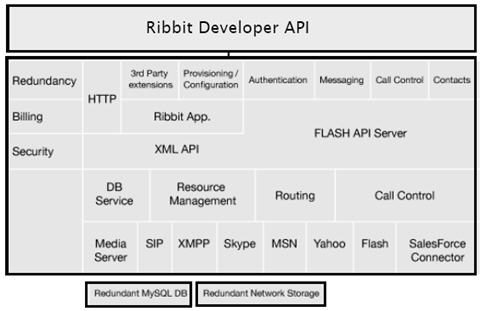Ribbit debuts Amphibian 'voiceware'

At Demo 08 Ribbit will take the wraps off its consumer 'voiceware' platform, code-named Amphibian. The new service turns any physical phone into a virtual phone, creating a platform for a wide variety of voice-enabled applications.
Currently in private beta and generally available in the second quarter of 2008, Amphibian allows developers to create “voiceware” on the Ribbit platform (below). So far Ribbit has attracted 2,500 developers, according to Crick Waters, co-founder and vice president of strategy and business development. "Voice is treated a data object and merged with applications," Waters told me.
The Ribbit Marketplace provides developers with a way to market and monetize applications, voice widgets, social feed widgets and other voiceware products and services. Ribbit will take a commission of about 10 percent to manage the economics of the marketplace, Waters said. In December Ribbit launched an an enterprise service that integrates with Salesforce.com. More than 30 companies are testing the service.
Among the features Ribbit supports are mobile message management, such as treating voice mail like email, speech to text transcription of voice mail (via SimulScribe for a fee) and a soft phone with voice mails, call logs and other features for making calls from any browser or Web page, such as Facebook, Netvibes, Pageflakes, iGoogle, MySpace,Plaxo and MyYahoo.
Ribbit offers a kind of phone mashup on its carrier grade soft switch, with embedded multi-protocol calling. For example, you can have a conversation via the Web and transfer the call to continue the conversation, Waters said.
Ribbit is also enabling what Ted Griggs, co-founder and CEO of Ribbit, described as Caller ID 2.0. Ribbit can access feeds from Flickr, Twitter, LinkedIn and others services and include them in a user profile.
Ribbit will end up running into Google's Android platform and even the iPhone as Apple opens up the device to developers next month. Ribbit differentiates itself by focusing on more than just handsets, but you can expect both Google and Apple to take a page from Ribbit's voiceware platform. What's clear is that the phone is about to take a giant leap into the Web. Ribbit plans to generate revenue from enterprise applications and advanced features, such as outbound dialing, click to dial with a home phone or answering mobile calls on an office or home phone, Waters said.
